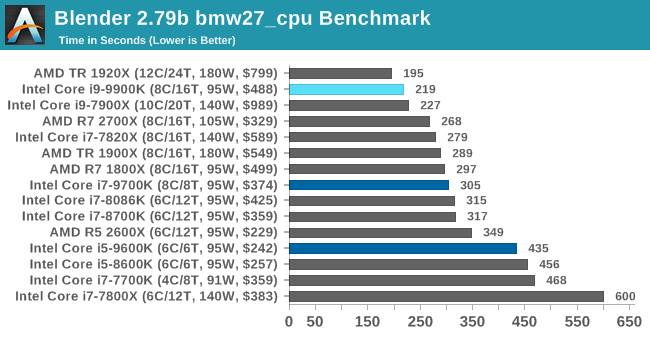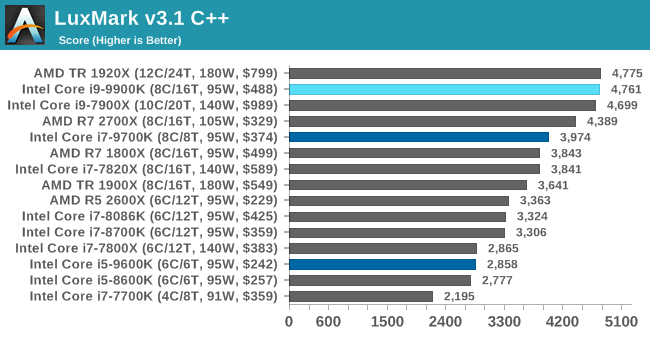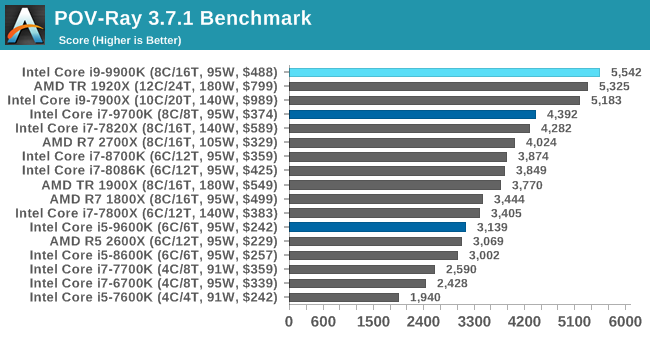The Intel 9th Gen Review: Core i9-9900K, Core i7-9700K and Core i5-9600K Tested
by Ian Cutress on October 19, 2018 9:00 AM EST- Posted in
- CPUs
- Intel
- Coffee Lake
- 14++
- Core 9th Gen
- Core-S
- i9-9900K
- i7-9700K
- i5-9600K
CPU Performance: Rendering Tests
Rendering is often a key target for processor workloads, lending itself to a professional environment. It comes in different formats as well, from 3D rendering through rasterization, such as games, or by ray tracing, and invokes the ability of the software to manage meshes, textures, collisions, aliasing, physics (in animations), and discarding unnecessary work. Most renderers offer CPU code paths, while a few use GPUs and select environments use FPGAs or dedicated ASICs. For big studios however, CPUs are still the hardware of choice.
All of our benchmark results can also be found in our benchmark engine, Bench.
Corona 1.3: Performance Render
An advanced performance based renderer for software such as 3ds Max and Cinema 4D, the Corona benchmark renders a generated scene as a standard under its 1.3 software version. Normally the GUI implementation of the benchmark shows the scene being built, and allows the user to upload the result as a ‘time to complete’.
We got in contact with the developer who gave us a command line version of the benchmark that does a direct output of results. Rather than reporting time, we report the average number of rays per second across six runs, as the performance scaling of a result per unit time is typically visually easier to understand.
The Corona benchmark website can be found at https://corona-renderer.com/benchmark

Corona is a fully multithreaded test, so the non-HT parts get a little behind here. The Core i9-9900K blasts through the AMD 8-core parts with a 25% margin, and taps on the door of the 12-core Threadripper.
Blender 2.79b: 3D Creation Suite
A high profile rendering tool, Blender is open-source allowing for massive amounts of configurability, and is used by a number of high-profile animation studios worldwide. The organization recently released a Blender benchmark package, a couple of weeks after we had narrowed our Blender test for our new suite, however their test can take over an hour. For our results, we run one of the sub-tests in that suite through the command line - a standard ‘bmw27’ scene in CPU only mode, and measure the time to complete the render.
Blender can be downloaded at https://www.blender.org/download/

Blender has an eclectic mix of requirements, from memory bandwidth to raw performance, but like Corona the processors without HT get a bit behind here. The high frequency of the 9900K pushes it above the 10C Skylake-X part, and AMD's 2700X, but behind the 1920X.
LuxMark v3.1: LuxRender via Different Code Paths
As stated at the top, there are many different ways to process rendering data: CPU, GPU, Accelerator, and others. On top of that, there are many frameworks and APIs in which to program, depending on how the software will be used. LuxMark, a benchmark developed using the LuxRender engine, offers several different scenes and APIs.

Taken from the Linux Version of LuxMark
In our test, we run the simple ‘Ball’ scene on both the C++ and OpenCL code paths, but in CPU mode. This scene starts with a rough render and slowly improves the quality over two minutes, giving a final result in what is essentially an average ‘kilorays per second’.


POV-Ray 3.7.1: Ray Tracing
The Persistence of Vision ray tracing engine is another well-known benchmarking tool, which was in a state of relative hibernation until AMD released its Zen processors, to which suddenly both Intel and AMD were submitting code to the main branch of the open source project. For our test, we use the built-in benchmark for all-cores, called from the command line.
POV-Ray can be downloaded from http://www.povray.org/












274 Comments
View All Comments
evernessince - Saturday, October 20, 2018 - link
I'm sure for him money is a fixed resource, he is just really bad at managing it. You'd have to be crazy to blow money on the 9900K when the 8700K is $200 cheaper and the 2700X is half the price.Dug - Monday, October 22, 2018 - link
Relative to how much you make or have. $200 isn't some life threatening amount that makes them crazy because they spent it on a product that they will enjoy. We spend more than that going out for a weekend (and usually don't have anything to show for it). If an extra 200 is threatening to your lively hood, you shouldn't be shopping for new cpu's anyway.close - Saturday, October 20, 2018 - link
@ekidhardt: "I think far too much emphasis has been placed on 'value'. I simply want the fastest, most powerful CPU that isn't priced absurdly high."That, my good man, is the very definition of value. It happens automatically when you decide to take price into consideration the price. I also don't care about value, I just want a CPU with a good performance to price ratio. See what I did there? :)
evernessince - Saturday, October 20, 2018 - link
A little bit extra? It's $200 more then the 8700K, that's not a little.mapesdhs - Sunday, October 21, 2018 - link
The key point being, for gaming, use the difference to buy a better GPU, whether one gets an 8700K or 2700X (or indeed any one of a plethora of options really, right back to an old 4930K). It's only at 1080p and high refresh rates where strong CPU performance stands out, something DX12 should help more with as time goes by (the obsession with high refresh rates is amusing given NVIDIA's focus shift back to sub-60Hz being touted once more as ok). For gaming at 1440p or higher, one can get a faster system by choosing a cheaper CPU and better GPU.
There are two exceptions: those for whom money is literally no object, and certain production workloads that still favour frequency/IPC and are not yet well optimised for more than 6 cores (Premiere is probably the best example). Someone mentioned pro tasks being irrelevant because ECC is not supported, but many solo pros can't afford XEON class hw (I mean the proper dual socket setups) even if the initial higher outlay would eventually pay for itself.
What we're going to see with the 9900K for gaming is a small minority of people taking Intel's mantra of "the best" and running with it. Technically, they're correct, but most normal people have budgets and other expenses to consider, including wives/gfs with their own cost tolerance limits. :D
If someone can genuinely afford it then who cares, in the end it's their money, but as a choice for gaming it really only makes sense via the same rationale if they've also then bought a 2080 Ti to go with it, though even there one could retort that two used 1080 TIs would be cheaper & faster (at least for those titles where SLI is functional).
If anything good has come from this and the RTX launch, it's the move away from the supposed social benefit of having "the best"; the street cred is gone, now it just makes one look like a fool who was easily parted from his money.
Spunjji - Monday, October 22, 2018 - link
Word.Total Meltdowner - Sunday, October 21, 2018 - link
This comment reads like shilling so hard. So hard. Please try harder to not be so obvious.Spunjji - Monday, October 22, 2018 - link
I think they placed just the right amount of emphasis on "value". Your post basically explains why it's not relevant for you in terms of you being an Intel fanboy with cash to burn. I'll elaborate.The MSRP is in the realm of irrational spending for a huge number of people. "Rational" here meaning "do I get out anything like what I put in", wherein the answer in all metrics is an obvious no.
Following that, there are a HUGE number of reasons not to pre-order a high-end CPU, especially before proper results are out. Pre-ordering *anything* computer related is a dubious prospect, doubly so when the company selling it paid good money to paint a deceptive picture of their product's performance.
Your assertion that Intel have never launched a bad CPU is false and either ignorance or wilful bias on your part. They have launched a whole bunch of terrible CPUs, from the P3 1.2Ghz that never worked, through the P4 Emergency Edition and the early "dual-core" P4 processors, all the way through to this i9 9900K which is the thirstiest "95W" CPU I've ever seen. Their notebook CPUs are now segregated in such a way that you have to read a review to find out how they will perform, because so much is left on the table in terms of achievable turbo boost limits.
Sorry, I know I replied just to disagree which may seem argumentative, but you posted a bunch of nonsense and half-turths passed off as common-sense and/or logic. It's just bias; none of it does any harm but you could at least be up-front that you prefer Intel. That in itself (I like Intel and am happy to spend top dollar) is a perfectly legitimate reason for everything you did. Just be open and don't actively mislead people who know less than you do.
chris.london - Friday, October 19, 2018 - link
Hey Ryan. Thanks for the review.Would it be possible to check power consumption in a test in which the 2700x and 9900k perform similarly (maybe in a game)? POV-Ray seems like a good way to test for maximum power draw but it makes the 9900k look extremely inefficient (especially compared to the 9600k). It would be lovely to have another reference point.
0ldman79 - Friday, October 19, 2018 - link
I'm legitimately surprised.The 9900k is starving for bandwidth, needs more cache or something. I never expected it to *not* win the CPU benchmarks vs the 9700k. I honestly expected the 9700k to be the odd one out, more expensive than the i5 and slower than the 9900k. This isn't the case. Apparently SMT isn't enabling 100% usage of the CPU's resources, it is allowing a bottleneck due to fighting over resources. I'd love to see the 9900K run against it's brethren with HT disabled.